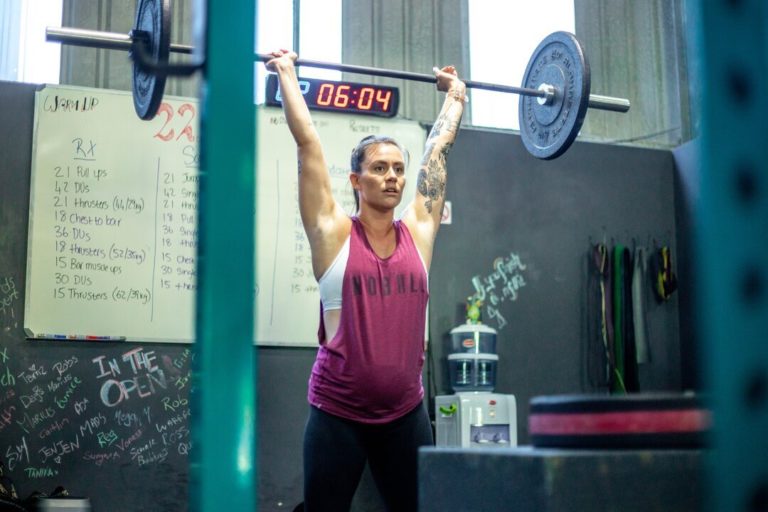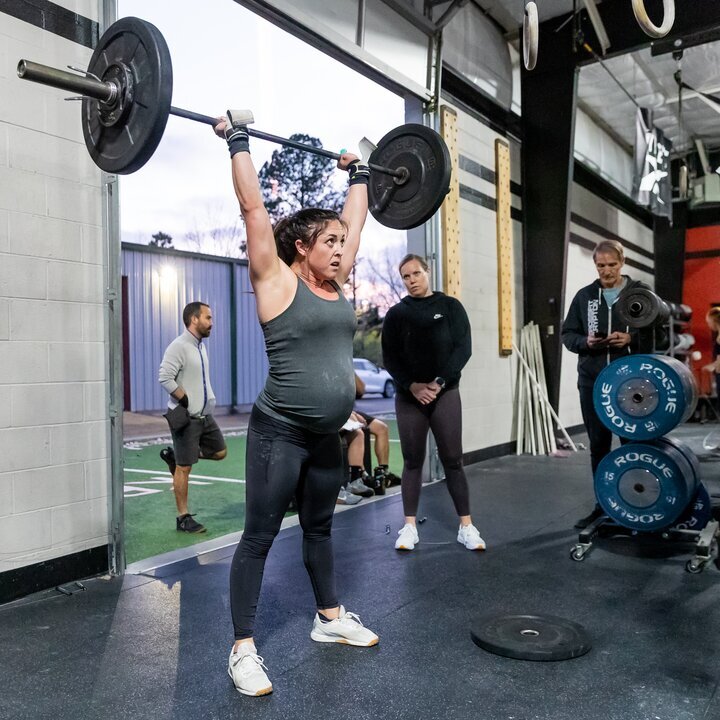Training pregnant and postpartum mothers may seem intimidating if you’ve never done it before. However, dedicating time to helping moms keep themselves healthy, happy, and fit can be an incredibly rewarding experience that will also strengthen your affiliate community. Additionally — and perhaps most importantly — it is our responsibility as coaches to meet the needs of our athletes on the training floor, including athletes recovering from surgery, athletes with a permanent physical limitation, and athletes who are pregnant or postpartum.
Recently, I sat down with Junior Edelman, owner of CrossFit Almere, to discuss how he and his coaching team have worked to optimize the training experience for pregnant and postpartum athletes. Junior and the coaches at his gym have trained dozens of moms over the past decade and their current membership includes five pregnant and six postpartum athletes.
When someone at the gym tells you “Coach, we have a baby on board!” What happens?
Junior: Well, first I hug her, then say “Congratulations!” I am happy for her, obviously. … Next, I find out her due date and loop [the athlete] into our operations for this population. We use a trimester calculator to get their data into our system, then we send out an email with information concerning how training shifts gears while pregnant. This first-trimester email includes practical guidelines as well as contacts of other women we have trained during their pregnancy. We include these names to help encourage support from others in our community. Over time, we send out more emails that correspond to the pregnancy and postpartum timeline.
 How do you explain how training will be different throughout different stages of the pregnancy and beyond?
How do you explain how training will be different throughout different stages of the pregnancy and beyond?
Junior: Within each trimester email are general guidelines for how we adapt training. This includes PDF charts with options for scaling specific movements. At our weekly staff meetings, we have a briefing on these athletes and where the women are in terms of training. We have found that making these scaling options readily available helps the athletes avoid feeling like they require a disproportionate amount of the coach’s time during a class. Most come to the gym with an idea of how they will scale the workout, and coaches are aware and prepared to help them adapt the workout of the day should they need to. If the options proposed in our scaling charts don’t feel right for that day for whatever reason, we work together to find something that does.
Where did you first learn about appropriate scaling for pregnant and postpartum athletes?
Junior: There are many more resources available now than there were when we first started training this population. Together with other coaches at the gym, we took a course on training while pregnant from a local group here in the Netherlands. This was oriented towards physical activity in general, not specifically CrossFit. I also did a lot of research online. Naturally, with this sort of research, you have to think critically, but there is a lot of useful information out there if you take the time to sift through it. Finally, I always try to learn as much as possible using feedback from my athletes. For example, we recently trained two women who had similar due dates. During their second trimesters, one felt uncomfortable while rowing, and the other felt completely fine. Fast-forward one month later, and the opposite was the case: The one who was previously uncomfortable rowing now felt great on the rower, while for the other, it did not feel right. We have also had cases where athletes are willing and able to perform high-volume body-weight movements, like lunges, but then feel that their recovery was not ideal.
Can you think of any particularly creative adaptation you have made for your athletes?
Junior: One time we had a workout that included a medicine-ball run. Instead of automatically sending the pregnant athletes to the bike, we told them to grab a medicine ball and hold it overhead while pedaling. I think that one was as memorable for them as it was for me to watch.
 Have you had any competitive athletes train through a pregnancy? If so, how did their approach differ from others’?
Have you had any competitive athletes train through a pregnancy? If so, how did their approach differ from others’?
Junior: Yes, we had a former coach compete at the Lowlands Throwdown during her first trimester. She had great body awareness and a solid understanding of what she could and should do. Naturally, as a competitive athlete, her starting point in terms of work capacity was higher than the average pregnant athlete we train. As a result, her training during pregnancy was also different from others’. She trained to be able to compete during the early phase of her pregnancy, and as time progressed, worked to position herself to have a healthy delivery and postpartum recovery.
How do you optimize the training experience for pregnant athletes?
Junior: Just like everyone else who trains at our affiliate, we help them reach their goals in a fun environment. We make sure they are integrated into the group dynamic, and we have seen that this helps these athletes feel great about their body and what it can do even though they are going through a lot of changes physically, psychologically, and hormonally.
How does taking care of pregnant athletes affect the CrossFit Almere community at large?
Junior: I think that those ladies get immense respect. Keeping them engaged within the group class structure has been inspiring for many others at the gym. We have often seen other members realize if so and so is pregnant and still training, then I can still do my stuff as well, even if I am a little grumpy or not feeling that well or have some aches or whatever it may be that day. These members remember that if we scale accordingly, they can still train well. Having pregnant athletes remain in group classes sets a powerful precedent.
How has your approach to coaching pregnant and postpartum athletes changed over the past 10 years?
Junior: We have been using this current structure with the trimester emails and personal references for support for the past three to four years. Before, we did not dig into the when, how, or why as much. What we are doing now is working much better. Before, coaches directed the adaptations much more heavily, whereas now, these athletes know more about the reasons why we choose certain options, and they feel empowered to participate more in the scaling process based on their individual needs on any given day. Including people to contact who have been through this process themselves has worked great to help support our pregnant and postpartum athletes.
It is clear that Junior and the CrossFit Almere team have worked to improve and refine their approach to training pregnant and postpartum athletes over the years. Junior is not a dad, but this has not stopped him or his team from taking the time to understand and coach these athletes at his affiliate. To be an effective coach, not only do we need to have the knowledge about how to appropriately scale for expecting mothers, but we also need to be able to apply that knowledge and adjust accordingly. Optimizing the training experience for pregnant and postpartum athletes will help to strengthen relationships within the affiliate and cultivate a community that supports the pursuit of health, happiness, and performance at all stages of life.
As professional coaches, we seek to be prepared to help anyone who walks through the doors. If you are not yet ready to coach pregnant or postpartum athletes, a good place to start is by reading “Pregnancy: A Practical Guide for Scaling” by Nicole Christensen, and printing out the scaling template she included as a reference. For recent information concerning the physical and psychological benefits of training while pregnant, see “Physical Activity and Exercise During Pregnancy and the Postpartum Period,” published in April 2020 in “Obstetrics & Gynecology.” Finally, reach out to someone who has experience coaching pregnant and postpartum athletes in or beyond the CrossFit community. Learning more about how others have found success working with these athletes will help increase your own confidence as a coach for future generations.
About the Author
Emily Jenkins works as a Head Trainer and Translator on the CrossFit Seminar Staff. She coaches out of her newly founded garage affiliate, CrossFit Iubhar, in Cantabria, Spain. Emily enjoys helping her 2-year-old learn how to do somersaults and is always on the lookout for a good read and a funny joke.